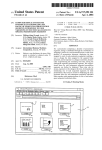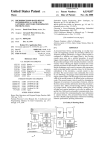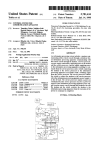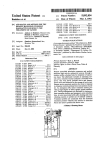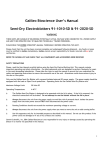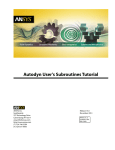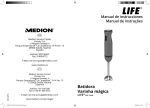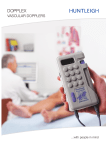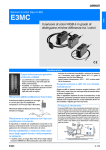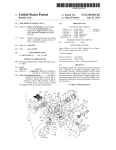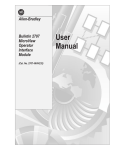Download System for tracing hardware counters utilizing programmed
Transcript
US006253338B1 (12) United States Patent (10) Patent N0.: Smolders (54) US 6,253,338 B1 (45) Date of Patent: Jun. 26, 2001 SYSTEM FOR TRACING HARDWARE 5,835,702 * 11/1998 Levine et al. ........................ .. 714/39 COUNTERS UTILIZING PROGRAMMEI) 5,991,708 * 11/1999 Levine et al. ...................... .. 702/186 PERFORMANCE MONITOR TO GENERATE 5,996,092 * 11/1999 Augsburg et al. 6,006,033 TRACE INTERRUPT AFTER EACH BRANCH * 6,067,644 * INSTRUCTION OR AT THE END OF EACH CODE BASIC BLOCK 12/1999 Heisch ... ... ... ... . 714/38 . . . . .. 717/9 5/2000 Levine et al. ........................ .. 714/47 OTHER PUBLICATIONS (75) Inventor: Luc Rene Smolders, Austin, TX (US) “Transition Records For Tracing Program Flows”, IBM (73) Assignee: International Business Machines Technical Disclosure Bulletin, Jun. 1996* “Transition Records For Tracing program FloWs On Ama Corporation, Armonk, NY (US) (*) Notice: Zon and POWERPC Machines”, IBM Technical Disclosure Bulletin, Nov. 1997.* Subject to any disclaimer, the term of this patent is extended or adjusted under 35 * cited by examiner U.S.C. 154(b) by 0 days. Primary Examiner—Meng-Al T. An Assistant Examiner—Nabil El-Hady (74) Attorney, Agent, or Firm—Volel Emile; BraceWell & Patterson, L.L.P. (21) Appl. No.: 09/224,121 (22) Filed: Dec. 21, 1998 (51) Int. Cl.7 ..................................................... .. H02H 3/05 (52) US. Cl. ............................... .. 714/45; 714/37; 714/38; (58) Field of Search ................................ .. 714/37, 35, 38, information handling system are disclosed for counting 714/47, 39, 4s, 45; 717/9; 711/125, 134; various events from a running program (hereafter called a (57) ABSTRACT A method and system Within a data processing system or 714/39; 714/47; 712/227 process) by taking a trace by Way of using an interruption. According to the present invention, a performance monitor 702/186 References Cited feature Within a data processing system is programmed to U.S. PATENT DOCUMENTS 395/704 the end of each basic block of code from a currently running program or process. By programming monitor mode control registers Within the performance monitor feature, one or Levine et al. ........................ .. 714/37 more counters are programmed to count various events (56) generate a trace interrupt after each branch instruction, or at 4,598,364 * 7/1986 Gum et a1. ........................... .. 714/38 5,274,811 * 12/1993 Borg et al. 5,446,876 * 5,564,028 5,594,864 8/1995 happening on the data processing system thereby creating 10/1996 SWoboda et al. . 1/1997 Trauben . 5,621,886 4/1997 Alpert et al. . 5,630,102 5/1997 Johnson et al. . 5,642,479 6/1997 Flynn . 5,717,881 5,724,566 2/1998 Beard et al. . 3/1998 SWoboda et al. . 5,740,414 4/1998 Tovey et al. . tracing information. If the current process is a process to be traced, the tracing information is stored in a trace buffer for post-processing analysis, the counters are reset to Zero returning back to the process from the interrupt. 15 Claims, 3 Drawing Sheets 44 Put Current mm Address and NINST In TISCE Builef = T 1 Em" PM“ A Process We Put Hardware l Counters lnlo. tn Trace Bulfer Tracing This Process 1 Next Block Address : Transition Address U.S. Patent Jun. 26, 2001 Sheet 1 of3 US 6,253,338 B1 22 Q8 >10 20 Fly. 1 J12 I|l H |l | l |H | | H U.S. Patent Jun. 26, 2001 US 6,253,338 B1 Sheet 2 0f 3 812 F PERFORMANCE NIONITOR 74L IvIIvICR 751 IvIMCR DMR 84 ] | J PIvIC ~f82 PMC J85 Q76 qs Q80 MSR PM 0 m “ BE M 32 V J26 ‘ INSTRUCTION ' FLOW UNIT J70 ‘ " J28 > EXECUTION UNITS A V V 68 SYSTEM 1 INTERFACE = V J = 66 L1 CACHE UNIT M J72 \ II J (F15. 2 U.S. Patent Jun. 26, 2001 Sheet 3 of3 Trace Interrupt US 6,253,338 B1 30 After Branch II I3 2 “I31 State Save V Next Block = ‘f3 4 fly‘ 3 Return Address J’ 3 8 Get Process Info. c4 4 Is This Put Current Block Address and NINST Bllggléezrsowj‘ In Trace Buffer v 45 Q Put Hardware Counters Info‘ _ : Ngtltrrglroislgg‘dress In Trace Buffer A’? We . Traclng Thrs Yes Process ? 52 Reset Hardware Counters ‘3 62 54 V v Restore State c “"ent P ‘mess Traced Current Process T=° T-1 _ V v v Return From lnterru t p 64 h g 233:8‘??? ‘ . . T T Transrtron Address 560 ‘V J5 6 Traced Put Process Info. 1 In Trace Buffer 58 US 6,253,338 B1 1 2 SYSTEM FOR TRACING HARDWARE COUNTERS UTILIZING PROGRAMMED PERFORMANCE MONITOR TO GENERATE TRACE INTERRUPT AFTER EACH BRANCH INSTRUCTION OR AT THE END OF EACH CODE BASIC BLOCK The foregoing objects are achieved as is noW described. A method and system Within a data processing system or information handling system are disclosed for counting various events from a running program (hereafter called a process) by taking a trace by Way of using an interruption. According to the present invention, a processor Within a data processing system is programmed to generate a trace inter BACKGROUND OF THE INVENTION 1. Technical Field The present invention relates in general to a method and 10 Within a performance monitor feature, one or more counters system for data processing and in particular to an improved method and system for counter level tracing. Still more particularly, the present invention relates to a method and system for tracing hardWare counters by Way of an inter ruption Without introducing any overhead or modifying the code being counted. 2. Description of the Related Art Most modern microprocessors, like members of the PoW rupt at least after each branch instruction, or at the end of each basic block of code from a currently running program or process. By programming monitor mode control registers are programmed to count various events happening on the data processing system thereby creating tracing information. 15 If the current process is a process to be traced, the tracing information is stored in a trace buffer for post-processing analysis, the counters are reset to Zero returning back to the process from the interrupt. The above as Well as additional objects, features, and advantages of the present invention Will become apparent in erPC family, provide hardWare counters that can be pro grammed to count various events happening on the proces sor. To date, tools have been built around these facilities the folloWing detailed Written description. BRIEF DESCRIPTION OF THE DRAWINGS (usually and hereafter referenced as Performance Monitor) The novel features believed characteristic of the invention for application and operating system tuning. Such tools report counter values over complete runs of Workloads to 25 are set forth in the appended claims. The invention itself hoWever, as Well as a preferred mode of use, further objects tune. In this mode, one resets the counters, programs the and advantages thereof, Will best be understood by reference performance monitor to count the desired events, runs the to the folloWing detailed description of an illustrative Workload to measure, and reads the counters after the embodiment When read in conjunction With the accompa Workload has completed. This procedure is limited in that it only provides global information, i.e. from start to ?nish, nying draWings, Wherein: Without the possibility of ?guring out Which part of the Workload is responsible for the counter increments. Which may be used to run a counter level tracing tool of the FIG. 1 is a block diagram of a data processing system present invention, Application Programming Interfaces (API) have also been built to collect counter information for portions of Workloads. In this mode, one must add calls to API code just FIG. 2 is a more detailed block diagram of the data 35 processing system of FIG. 1, and before and immediately after the execution of the portion of FIG. 3 is a How diagram depicting the overall sequence of the Workload to analyZe. The former is to setup and start the operations performed by the counter level tracing tool in counting and the latter is to stop the counting and retrieve the accordance With the present invention. results. Those API calls can either be added directly to the source code if it is available or by Way of instrumentation, i.e. dynamic insertion of code to divert normal execution DETAILED DESCRIPTION OF ILLUSTRATIVE EMBODIMENT path. This technique provides loWer granularity results than the global counting of the previous approach, but at a big cost due to the overhead of the outside code necessary to control the counting. The overhead is What directly limits the obtainable granularity of the results. Consequently, it Would be desirable to provide an improved method and system that determines Which part of 45 invention. The processor comprises a single integrated cir cuit pipelined superscalar microprocessor. Accordingly, as discussed further beloW, the processor includes various a Workload is responsible for counter increments of desired events Without any overhead. In particular, it Would be eXecution units, registers, buffers, memories, and other functional units, Which are all formed from integrated cir cuitry. The processor preferably comprises one of the PoW erPCTM line of microprocessors available from IBM Micro desirable to provide an improved method and system Which utiliZes a performance monitor facility and generates an eXception after each branch instruction for gaining control at a basic block level for counting various events happening on a microprocessor. 55 PowerPCTM 604 RISC Microprocessor User’s Manual, Which is incorporated herein by reference. Turning once again to FIG. 1, the data processing system 10 comprises system processor unit 12 and display 18, It is therefore one object of the present invention to provide an improved method and system for data process ing. It is another object of the present invention to provide an overhead or modifying the code. electronics (e.g., the PoWerPCTM 604), Which operate according to reduced instruction set computing (RISC) techniques. Details concerning the architecture and opera tion of the PoWerPCTM 604 processor may be found in the SUMMARY OF THE INVENTION improved method and system for counter level tracing. It is yet another object of the present invention to provide an improved method and system for tracing hardWare counters by Way of an interruption Without introducing any With reference noW to the ?gures and in particular With reference to FIG. 1, there is illustrated a preferred embodi ment of a data processing system 10 that includes a proces sor Which employs the method and system of the present keyboard 20, and mouse 22. As is Well-knoWn to those skilled in the art, a user inputs data to system processor unit 65 12 utiliZing keyboard 20, mouse 22, or other suitable input device. Although only one processor unit is depicted in the eXemplary embodiment, those skilled in the art Will appre ciate that additional processor units may be utiliZed in a US 6,253,338 B1 3 4 multiprocessor data processing system in accordance With handling the trace interruptions Will have to check for branch instructions. When a branch is found, the How of execution proceeds as described beloW in FIG. 3, if the the present invention. With reference noW to FIG. 2, there is depicted a more detailed block diagram of system processor unit 12. As illustrated, system processor unit 12 includes L1 instruction Was not a branch, the How of execution simply returns to the next instruction in sequence Without any cache 66, system interface unit 68, instruction ?oW unit 26, and execution units 28. System interface unit (SIU) 68 is additional action. In summary, the method and system of the present invention may be applied to any system processor connected to L1 cache 66, Which comprises a small, rela tively fast portion of memory that stores data and instruc tions retrieved from loWer levels of memory via processor Which is able to generate a trace interrupt after each branch bus 72. Data and instructions stored Within L1 cache 66 are processes, and a Way to automatically halt or stop counting of code, to count selected events during one or more 10 retrieved as required by instruction ?oW unit 26, Which then When an interrupt occurs. dispatches instructions to selected ones of execution units 28 The method and system employed in the counter level tracing tool 31 of the present invention Will noW be described With reference to the ?oWchart shoWn in FIG. 3. As described above, the instruction ?oW unit of the system processor unit 12 generates a trace interrupt after each for execution. The execution units 28 comprise one or more ?xed-point execution units, load/store execution units, and ?oating-point execution units. As Will be appreciated by those skilled in the art, the provision of multiple execution 15 units 28 enables system processor unit 12 to execute mul branch instruction or at the end of each basic block of code tiple instructions during each processor cycle. In addition, as shoWn in step 30. By programming the monitor mode control register 74 to have the performance monitor counter 82 count instructions, the siZe of each basic block of code is determined. In the next step 32, after each branch instruction a trace interrupt is generated by step 30 and the performance monitor halts counting such that it does not count the interrupt handler code, the counter level tracing tool 31 then system processor unit 12 includes a machine state register 76 and a performance monitor feature 24, Which monitors activity Within each functional unit of the system processor unit 12 via internal bus 70. Referring once again to FIG. 2, the folloWing procedure may be used to prepare the system processor unit 12 to execute the method and system of the present invention. By Way of example but not of limitation, the aforementioned 25 PoWerPCTM 604 processor and its associated counters and registers are used to demonstrate this preparation procedure. As shoWn in FIG. 2, Within the performance monitor 24 are monitor mode control registers (MMCR) 74 and 75, respectively, used for programming and one or more asso ciated performance monitor hardWare counters (PMC) 82 and 85 that used for counting operations. It should be understood that there might be more than tWo-monitor mode control registers (MMCR) 74 and 75 and their associated performance monitor hardWare counters (PMC) 82 and 85 used in the present invention. First, the monitor mode control registers, 74 and 75 respectively, contain instructions 35 for instructing their respective performance monitor trace enable bit 80 doing the tracing and the performance monitor bit 78 doing the counting in the machine state counters, 82 and 85 respectively, to count a speci?ed event. By Way of example, but not of limitation, these types of events may include counting the number of cycles during a selected executing process or the number of load/store misses occurring Within an L2 cache. Next, to halt or stop counting selected or speci?ed events When an interrupt occurs, a performance monitor bit 78 is utiliZed Within the machine state register 76. One of the monitor mode control register 76 are reset to Zero. This Will cause a discontinuity in the trace, ie to abruptly stop counting selected events and 45 special processing Within the operating system and the invention and therefore not detailed here. When returning to user mode from kernel mode, there is caused a discontinuity referred to as an “out transition” just before a user level halt or stop counting events for all of the hardWare counters When the performance monitor bit 78 is not on. An advan thread is resumed. At these points in the trace, similar special processing is also needed. For those transitions the return tage of the performance monitor bit 78 is that it is architec address in user mode (i.e. the address the processor Will turally reset on interrupt on all PoWerPCTM processors and When used in combination With the DMR bit 84 automati 55 Tracing Program FloWs,” IBMTM Technical Disclosure Bulletin, Vol. 39, No. 06, Jun. 1996, pg.11. traced. Lastly, the instruction ?oW unit 26 is programmed to generate a trace interrupt after each branch by setting a speci?ed branch trace enable bit 80 in the machine state register 76. When using a processor different than the In the preferred embodiment, in order to be able to get a complete trace, i.e., not limited to a single process, the counter level tracing tool keeps track of the current process information (by Way of example but not of limitation a POWERPC 604, used here by Way of example only if such processor used does not have a branch tracing mode, ie the equivalent of the BE bit in the MSR and an automatic trace interruption after each instruction. In such a case, the code jump to after it exits the kernel mode) is saved by the operating system and made available to the counter level tracing tool. This is referenced to as the transition address. One example of this is shoWn in “Transition Records for the machine state register 76 is set for the program to be interruption after each branch, the processor Would be programmed in single-step mode, ie to generate a trace generate a trace interrupt While in the middle of a basic block. This point is referred to as an “in transition” requiring tracing tool Which is beyond the scope of the present registers 74 is programmed With a speci?ed disabled bit 84 (DMR) set Within the monitor mode control register 74 to cally stops all counters When the interrupt handler code starts executing. Also, the performance monitor bit 78 Within saves the current state (registers) information of the program being traced for later use. Since the counter level tracing tool 31 may use these registers, the state (registers) information is saved in memory during the execution of the method and system of the present information and then restored before returning from the interrupt, as Will be more fully described beloW. Thereafter, the counter level tracing tool 31 saves the address of the beginning of the next basic block of code, Which is the address Where the interruption came from as shoWn in step 34. It is knoWn by those skilled in the art, that it is dif?cult to trace code When it is changing execution mode (from user mode to kernel mode and vice-versa). When a system call is executed or an exception occurs, ie the changing of the execution mode from user mode to kernel mode, the branch process identi?er (PID), thread identi?er (TID), and pro 65 gram name Referring once again to FIG. 3, the next step 36 is a decision step, Which determines Whether or not a neW process has been dispatched. For the counter level tracing US 6,253,338 B1 5 6 tool of the present invention, to see if a neW process has been tools and application programming interfaces is that the dispatched, the process information is checked for changes. It is safe to check for such changes only When the newly dispatched process is exiting the kernel, i.e., When in an “out transition,” because the process information is only relevant counter level tracing tool does not introduce any overhead and therefore alloWs ?ne analysis of the counter increments at the basic block level. When using prior art techniques, global counting tools, no overhead is introduced either, but the granularity of the results is from start to ?nish, making When in user mode. Therefore, if it is not an “out-transition” then the process continues to decision step 46 to determine if it is a block of code from a desired process as Will be more ?ne analysis impossible. When using prior art API, loWer granularity of results can be produced but only up to a certain limit determined by the overhead introduced. The overhead is caused by the counting of the API code itself. With the present invention, the code of the counter level tracing tool is not counted therefore introducing no overhead fully discussed beloW. If the decision step 36 is an out transition, the process information is read as shoWn in step 38. The next step is a decision step 40 to determine if the current basic block of code belongs to a neW process by checking the current process information for changes. If it is not then the counter level tracing tool 31 continues to decision step 46, as Will be more fully described beloW. at all. It is also important to note that although the present 15 If it is a neW process then the method and system of the invention has been described in the context of a fully functional counter level tracing too, those skilled in the art Will appreciate that the mechanisms of the present invention present invention continues to decision step 48, to determine, in accordance With prior user input, Whether or not the process is to be traced. Step 56 shoWs that if the are capable of being distributed as a program product in a variety of forms to any type of information handling system, and that the present invention applies equally regardless of the particular type of signal bearing media utiliZed to actually carry out the distribution. Examples of signal bear ing media include, Without limitation, recordable type media current process is to be traced then a variable T is set equal to one Wherein the next step 58 puts the process information, (for example, the PID, TID and program name) into a trace buffer and continues to step 60. Step 54 shoWs that if the such as ?oppy disk or CD ROMs and transmission type current process is not to be traced, T is set equal to Zero and 25 media such as analog or digital communications links. continues to step 60. Thereafter, step 60 sets the next block address equal to a transition address, the next address to be executed in the program and returns to decision step 46. Therefore, each time the process information changes, a special record of this information is put into a trace buffer. It should be noted that because of the “out transition” records, that marks the return from kernel to user mode, this While the invention has been particularly shoWn and described With reference to a preferred embodiment, it Will be understood by those skilled in the art that various changes in form and detail may be made therein Without departing from the spirit and scope of the invention. What is claimed is: 1. A method for tracing hardWare counters in a data operation is accomplished very ef?ciently by the counter level tracing tool. processing system, said method comprising the steps of: If it is determined that the transition is not an out 35 transition, the method and system of the present invention executing a basic block of code from a current process; programming monitor mode control registers to instruct continues to decision step 46 to determine if the block of one or more hardWare counters to count speci?ed code is from a desired process previously speci?ed by the user. If it is then the current basic block address (i.e. tracing information) and the value of the hardWare counters, 74 and 75, respectively, are placed in the trace buffer, as shoWn in steps 44 and 45, and the counter level tracing tool 31 events; continues to step 50. If the block of code does not belong to a Wanted process the counter level tracing tool 31 continues to step 50 Wherein the current basic block address is set equal to the next basic block address. The counter level tracing tool 31 then resets the hardWare counters, 74 and 75 to Zero and restores the previous state counting said speci?ed events by said one or more hard Ware counters during said current process; generating a trace interrupt during said counting of speci ?ed events; responsive to generating said trace interrupt, determining 45 contents of said one or more hardWare counters in a trace buffer; determining for a kernel-mode-to-user-mode transition if (registers) information, shoWn respectively by steps 52 and said block of code belongs to a neW process from 62. At that point the counter level tracing tool 31 has completed its operation at 64 With a return from the inter current process information, Wherein if said block of code belongs to a neW process, further determining if rupt. said neW process is selected to be traced such that a The counter level tracing tool produces at least tWo ?les; one Which contains the actual trace of basic blocks of code and counter information as they Were executed and a feW 55 ated With said neW process into a trace buffer and setting a next block address equal to a transition 60 address; and Wherein, in response to determining that said neW process is not to be traced, setting a next block address equal to depicted in the exemplary embodiment, in a multiprocessor data processing system, one trace ?le is produced per It therefore should be appreciated that the advantage of using the present invention versus prior art global counting trace interrupt; is to be traced, storing the process information associ of the trace buffer). The other ?le contains the list of executables traced and their basic block of code, and option ally all the instructions in each of these blocks. This ?le is processor and the basic block ?le is built based on the content of all trace buffers. next block address may be determined folloWing said Wherein in response to determining that said neW process special records marking process changes (i.e. simply a copy built by the counter level tracing tool based on the contents of the trace buffer. Although only one processor unit is if said current process is selected to be traced, Wherein if said current process is selected to be traced, storing a transition address. m5 2. The method of claim 1, Wherein said executing a basic block of code further comprises the step of: setting a performance monitor bit Within a machine state register for said process to be traced. US 6,253,338 B1 8 7 3. The method of claim 1, wherein said generating said trace interrupt further comprises the step of: processing means for setting a performance monitor bit Within a machine state register for said program to be traced. programming an instruction ?oW unit to generate said 10. The information handling system of claim 9, Wherein said processing means for generating said trace interrupt trace interrupt by setting a speci?ed branch trace enable bit in a machine state register. further comprises: 4. The method of claim 3, Wherein said generating said trace interrupt further comprises the step of: processing means for programming an instruction ?oW unit to generate said trace interrupt by setting a speci programming a monitor mode control register to set a speci?ed disable bit Within said monitor mode control register to stop counting said speci?ed events When a performance monitor bit is not set such that interrupt ?ed branch trace enable bit in said machine state 10 register. 11. The information handling system of claim 10, Wherein said processing means for halting instructions counting handler instructions are not counted into current state further comprises: information. 5. The method of claim 4, Wherein said storing said processing means for programming a monitor mode con contents of said one or more hardWare counters further 15 comprises the step of: resetting said hardWare counters to Zero and restoring said trol register to set said speci?ed disabled bit Within said monitor mode control register to stop counting said speci?ed events When said performance monitor bit is not on Wherein an interrupt handler code is not counted state information. and state (registers) information is stored. 12. The information handling system of claim 11, Wherein 6. The method of claim 1, Wherein said storing contents of said one or more hardWare counters further comprises the said processing means for storing contents of said one or more hardWare counters further comprises: saving a beginning address of a next basic block of code processing means for saving an address of a beginning of of said current process being traced. a next basic block of code of said current process being 7. The method of claim 1, Wherein said determining if said 25 traced. step of: current process is to be traced further comprises the step of: determining if said block of code belongs to a desired 13. The information handling system of claim 12, Wherein said processing means for determining if said current pro cess to be traced further comprises: processing means for determining if said block of code process, Wherein if it is a desired process storing a current address and current count information in said trace buffer and setting a current block address equal to belongs to a desired process Wherein if it is a desired process placing a current address and said count infor mation in said trace buffer and setting a current block a next block address. 8. An information handling system, comprising: processing means for executing a basic block of code address equal to said next block address. 14. The information handling system of claim 13, Wherein from a current process; processing means for programming monitor mode control 35 registers to instruct one or more hardWare counters to or more hardWare counters comprises: count speci?ed events; processing means for counting said speci?ed events by processing means for resetting said hardWare counters to Zero and restoring said state (registers) information. 15. A computer program product residing on a computer usable medium for providing counter level tracing for an said one or more hardWare counters during said current process; information handling system, said computer program prod uct comprising: processing means for generating a trace interrupt during said counting of speci?ed events; processing means for determining if said current process is selected to be traced; processing means responsive to said current process being said processing means for storing said contents of said one instruction means for executing a basic block of code from a current process; 45 instruction means for programming monitor mode control registers to instruct one or more hardWare counters to selected to be traced for storing contents of said one or count speci?ed events; instruction means for counting said speci?ed events by more hardWare counters in a trace buffer; processing means for determining for a kernel-mode-to user-mode transition if said block of code belongs to a neW process from current process information; said one or more hardWare counters during said current processing means responsive to determining that said process; instruction means for generating a trace interrupt during block of code belongs to a neW process for determining if said neW process is selected to be traced such that a next block address may be determined folloWing said instruction means responsive to said trace interrupt for determining if said current process is selected to be trace interrupt; processing means responsive to determining that said neW process is to be traced for storing the process informa said counting of speci?ed events; and 55 traced; instruction means responsive to determining that said current process is to be traced for storing contents of tion associated With said neW process into a trace buffer said one or more hardWare counters in a trace buffer; and setting a next block address equal to a transition processing means responsive to determining that said neW instruction means for determining for a kernel-mode-to user-mode transition if said block of code belongs to a neW process from current process information; process is not to be traced for setting a next block address equal to a transition address. instruction means responsive to determining that said block of code belongs to a neW process for determining address; and 9. The information handling system of claim 8, Wherein if said neW process is selected to be traced such that a said processing means for executing a basic block of code next block address may be determined folloWing said further comprises: trace interrupt; US 6,253,338 B1 9 instruction means responsive to determining that said neW process is to be traced for storing the process information associated With said neW process into a trace buffer and setting a neXt block address equal to a transition address; and 10 instruction means responsive to determining that said neW process is not to be traced for setting a neXt block address equal to a transition address. * * * * *









